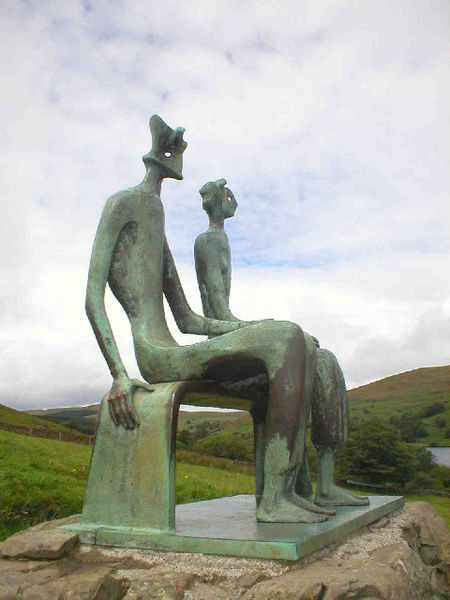Henry Moore may be regarded as one of the greatest British artists of the 20th century, but a group of Columbia University students have nevertheless rejected his work as ‘hideous’. The announcement that that his Reclining Figure (1969–70) will be installed in front of the school’s Butler Library caused a stir recently, with some 1,200 students protesting against the installation of this ‘lumpy hulk of metal’.
This opposition to an artist who famously wanted his art to speak to a wider public may come as a surprise. Yet this is not the first time that Moore’s work has been on the receiving end of hostility…
Stolen and sold for scrap
The value of Moore’s Reclining Figure was also low in the eyes of the thieves who stole a different cast of the same sculpture in December 2005. When it was filched from the Henry Moore Foundation in Perry Green, police initially feared that the sculpture had been stolen to order. Further investigations suggested, however, that it had been taken by a group of travellers who sold the work as scrap metal. The two-tonne Reclining Figure was worth £3 million, but melted down it would only have been worth £1,500.
Moore’s sculptures have proven a popular target for thieves. In October 2013, Standing Figure (1950) was stolen from Glenkiln Sculpture Park, and the criminals behind it have yet to be caught. The theft of Sundial (1965) in July 2012 from the Henry Moore Foundation had a happier ending, however. The thieves took Sundial and its plinth to a scrapyard, selling them for £46 and £182.60 respectively, even though the sculpture had been valued at up to £500,000. But following a televised appeal on Crimewatch the scrap merchant alerted the police and the sculpture was returned.
King and Queen (1952–53) in the Glenkiln Estate. Photo: Paddy Heron

Vandalism, decapitation and tea cosies
In March 1995, the Herald Scotland reported that Moore’s sculpture King and Queen (1952–53) had been decapitated: vandals had sawn off the bronze heads of the seated male and female figures. The sculpture, which stands on the grounds of Henry Keswick’s Glenkiln Estate in Dumfries, was subsequently repaired.
This extreme act of art vandalism was not the only one suffered by Moore’s sculptures. When Recumbent Figure (1938) was on display at MoMA’s sculpture garden in June 1944, two men broke in and knocked it off its plinth, cracking the figure’s head in the process. Since its unveiling in 1956, Moore’s Family Group (1954–55) in Harlow has also been a target: one of the figures was once dressed with a tea cosy, and on another occasion each of the heads were given green whiskers. When someone threw a brick at the sculpture and broke off the child’s head in 1963, the work was moved to a higher pedestal to protect it.
Draped Seated Woman (1957–58), Henry Moore.

A reputational rollercoaster
In October 2012, the mayor of the London Borough of Tower Hamlets, Lutfur Rahman, announced the council’s intention to sell Moore’s Draped Seated Woman (1957–58), which had been acquired in 1962 as part of London’s Patronage of the Arts Scheme. The sale was expected to raise up to £20 million, which would have gone some way to easing a £100 million budget cut that the council was facing at the time.
Not everyone minded. Writing in the Spectator, critic Niru Ratnam argued that the artwork was no longer ‘relevant’, and that a sculpture intended for a post-war nation could no longer speak to the borough’s inhabitants. There were, however, several campaigns to prevent the sale, and in July 2015 Rahman’s successor John Biggs announced the reversal of the decision.
Two Piece Reclining Figure No. 1 (1959), Henry Moore. Photo: Stu Smith

A dominating presence
Poor Moore has also come under fire for being, if anything, too popular. In 1967, the announcement that Moore was going to give a selection of his sculptures to the Tate concerned young British artists who felt the gallery was dedicating too large proportion of its space and funding to a single artist. Forty-one artists signed an open letter to The Times, including two of his previous assistants Anthony Caro and Phillip King.
The letter was representative of the alienation felt by artists in response to Moore, who by the 1960s was routinely acclaimed as Britain’s ‘greatest’ artist. For the artist Steve Claydon, Moore’s Two Piece Reclining Figure No. 1 (1959) in the forecourt of Chelsea School of Art, where Claydon was a student, was ‘like an unwelcome uncle whose apparent intention is to embarrass you in front of your friends.’
Decades later, it seems Moore still has the capacity to upset students on campus. Yet while Claydon riled against Moore for being old-fashioned, the criticisms made by the Columbia students today sound oddly reactionary. Here’s hoping they limit themselves to angry letters – or at most, a dissident tea cosy or two.


